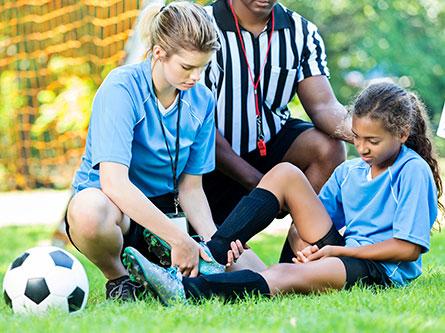In recent years, injuries among youth athletes have been steadily increasing, raising concerns among parents, coaches, and medical professionals alike. According to experts at UCLA Health, a combination of factors-including intensified training regimens, early sports specialization, and insufficient rest-may be contributing to this troubling trend. As participation in organized sports continues to grow, understanding the root causes behind rising injury rates is essential to safeguarding the health and futures of young athletes nationwide.
Rising Injury Rates Among Youth Athletes Prompt Concern Among Experts
Recent studies reveal a troubling surge in injuries among young athletes, sparking heightened concern among medical professionals and coaches alike. Experts attribute this increase to a combination of factors, including early sports specialization, insufficient rest periods, and an increase in competitive pressure at younger ages. The intense focus on a single sport year-round leaves young bodies vulnerable to overuse injuries such as stress fractures, tendonitis, and chronic joint pain. Additionally, a lack of proper conditioning and inadequate recovery times further exacerbate the risk of injury, threatening long-term physical health and athletic development.
Medical professionals emphasize several key contributors to this growing trend:
- Early specialization: Children focusing on one sport exclusively before puberty
- Increased volume and intensity: Excessive training sessions without adequate rest
- Psychological stress: Pressure to perform leading to burnout and injury
- Limited access to proper coaching: Inadequate technique training raising injury risk
| Injury Type | Common Cause | Typical Recovery Time |
|---|---|---|
| Stress Fracture | Overuse, repetitive impact | 6-8 weeks |
| Tendonitis | Improper technique, overtraining | 4-6 weeks |
| ACL Tear | Sudden pivot, poor conditioning | 6-9 months |
Overtraining and Early Specialization Identified as Key Risk Factors
Increasingly, youth athletes are facing physical setbacks directly linked to excessive training routines without adequate rest. The pressure to excel early in sports careers leads many young players to push beyond their physiological limits, resulting in chronic injuries and prolonged recovery times. Experts emphasize that the lack of scheduled rest and cross-training not only weakens developing muscles and joints but also causes burnout, which can prematurely end promising athletic journeys.
Equally concerning is the trend toward early specialization, where children focus intensely on a single sport year-round. This narrow focus restricts overall athletic development and significantly raises injury risk. Research shows that kids who specialize early are:
- 60% more likely to experience overuse injuries
- Twice as prone to psychological stress
- At greater risk of decreased long-term participation in sports
| Risk Factor | Impact on Youth Athletes |
|---|---|
| Overtraining | Muscle fatigue, stress fractures, burnout |
| Early Specialization | Higher injury rates, diminished skill diversity |
The Role of Proper Coaching and Safe Training Practices in Prevention
Effective coaching plays a critical role in reducing injury risks among youth athletes. Coaches who emphasize proper technique, gradual skill development, and individualized training foster safer environments where young athletes can thrive. By prioritizing education on body mechanics and enforcing age-appropriate training loads, coaches not only improve performance but also significantly lower chances of overuse injuries and acute trauma. Encouraging open communication between athletes, coaches, and parents ensures that warning signs are recognized early and addressed promptly.
Safe training practices extend beyond the coach’s direction and include structured warm-ups, adequate rest periods, and the integration of cross-training to enhance overall physical resilience. The table below outlines some key components of a safe youth training program, highlighting how each element contributes to injury prevention:
| Training Component | Benefit |
|---|---|
| Dynamic Warm-Ups | Prepares muscles & joints, reducing strain. |
| Progressive Skill Building | Prevents overuse and improper technique. |
| Rest & Recovery Days | Allows healing and prevents burnout. |
| Cross-Training | Enhances overall strength and flexibility. |
| Hydration & Nutrition Education | Supports energy and muscle repair. |
UCLA Health Recommends Holistic Approaches to Protect Young Athletes’ Wellbeing
Recognizing the growing prevalence of injuries among young athletes, UCLA Health emphasizes a holistic approach that goes beyond traditional injury treatment. Experts suggest incorporating physical conditioning, mental health support, and proper nutrition to foster resilience and reduce injury risk. Coaches and parents are encouraged to prioritize balanced training schedules, ensuring adequate rest and recovery, while tailoring activity levels to the developmental stage of each child. This comprehensive strategy not only targets physical well-being but also addresses psychological factors that can impact performance and susceptibility to injury.
To further illustrate effective preventative measures, UCLA Health highlights the following key components:
- Cross-training: Engaging in diverse physical activities to avoid repetitive strain.
- Mindfulness practices: Techniques such as meditation to improve focus and reduce stress.
- Education: Teaching young athletes about proper technique and body awareness.
- Nutrition: Balanced diets that support growth and recovery.
- Regular screenings: Early detection of potential issues through health assessments.
| Focus Area | Recommended Actions |
|---|---|
| Physical Conditioning | Strength training, flexibility exercises, rest days |
| Mental Health | Stress management, counseling, team support |
| Nutrition | Balanced meals, hydration, supplements if needed |
In Summary
As injury rates among youth athletes continue to climb, understanding the underlying causes becomes increasingly urgent. Experts point to factors such as early sport specialization, increased training intensity, and insufficient recovery as key contributors. Addressing these issues will require a coordinated effort from coaches, parents, healthcare providers, and sports organizations to prioritize safe practices and promote long-term athlete health. Without such measures, the rising trend in youth sports injuries may persist, undermining both performance and well-being.





